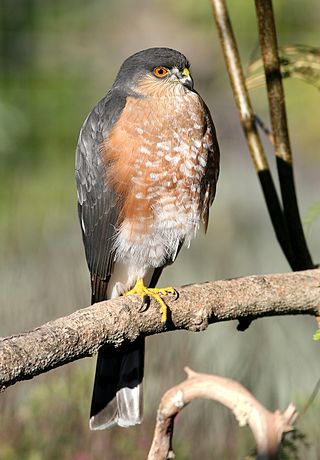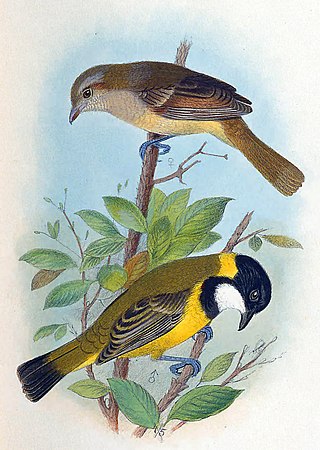
The sharp-shinned hawk or northern sharp-shinned hawk, commonly known as a sharpie, is a small hawk, with males being the smallest hawks in the United States and Canada, but with the species averaging larger than some Neotropical species, such as the tiny hawk. The taxonomy is far from resolved, with some authorities considering the southern taxa to represent three separate species: white-breasted hawk, plain-breasted hawk, and rufous-thighed hawk. The American Ornithological Society and some other checklists keep all four species conspecific.

The grey shrikethrush or grey shrike-thrush, formerly commonly known as grey thrush, is a songbird of Australasia. It is moderately common to common in most parts of Australia, but absent from the driest of the inland deserts. It is also found in New Guinea.

The flame robin is a small passerine bird native to Australia. It is a moderately common resident of the coolest parts of south-eastern Australia, including Tasmania. Like the other two red-breasted Petroica robins—the scarlet robin and the red-capped robin—it is often simply called the robin redbreast. Like many brightly coloured robins of the Petroicidae, it is sexually dimorphic. Measuring 12–14 cm (4.7–5.5 in) long, the flame robin has dark brown eyes and a small thin black bill. The male has a brilliant orange-red chest and throat, and a white patch on the forehead above the bill. Its upper parts are iron-grey with white bars, and its tail black with white tips. Female coloration is a muted grey-brown. Its song has been described as the most musical of its genus.

The orange-bellied parrot is a small parrot endemic to southern Australia, and one of only three species of parrot that migrate. It was described by John Latham in 1790. A small parrot around 20 cm (8 in) long, it exhibits sexual dimorphism. The adult male is distinguished by its bright grass-green upper parts, yellow underparts and orange belly patch. The adult female and juvenile are duller green in colour. All birds have a prominent two-toned blue frontal band and blue outer wing feathers.

The turquoise parrot is a species of parrot in the genus Neophema native to Eastern Australia, from southeastern Queensland, through New South Wales and into North-Eastern Victoria. It was described by George Shaw in 1792. A small lightly built parrot at around 20 cm (7.9 in) long and 40 g in weight, it exhibits sexual dimorphism. The male is predominantly green with more yellowish underparts and a bright turquoise blue face. Its wings are predominantly blue with red shoulders. The female is generally duller and paler, with a pale green breast and yellow belly, and lacks the red wing patch.

The Christmas imperial pigeon or Christmas Island imperial pigeon, also known as Black imperial pigeon, Dusky imperial pigeon, Wharton's imperial pigeon, or burong pergam, is a large imperial pigeon endemic to Christmas Island in the northeastern Indian Ocean. It has an overall grey-blue colouration, and juveniles are duller than adults. It makes a soft purring coo sound and a deeper whoo sound comparable to a cow mooing. It lays one glossy white egg per brood, and is possibly somewhat colonial.

The fauna of Colombia is characterized by a high biodiversity, with the highest rate of species by area unit worldwide.

The Macquarie shag, Macquarie Island shag or Macquarie Island cormorant, is a marine cormorant native to Macquarie Island in the Southern Ocean, about halfway between Australia and Antarctica.

The Norfolk thrush, also known as the grey-headed blackbird or guava bird, was a bird in the thrush family endemic to Norfolk Island, an Australian territory in the Tasman Sea. It is the extinct nominate subspecies of the island thrush.

The Taiwan thrush is a bird in the thrush family. It is endemic to Taiwan.

The Norfolk boobook, also known as the Norfolk Island boobook, Norfolk Island owl or Norfolk Island morepork, is a bird in the true owl family endemic to Norfolk Island, an Australian territory in the Tasman Sea between Australia and New Zealand. It is a subspecies of the morepork.

The Lord Howe currawong, Lord Howe Island currawong or Lord Howe pied currawong, is a large and mainly black passerine bird in the family Artamidae. It is endemic to Lord Howe Island in the Tasman Sea, part of New South Wales, Australia, and is a threatened subspecies of the pied currawong.

The Lord Howe golden whistler, also known as the Lord Howe whistler or Lord Howe Island golden whistler, and locally as the “robin” or “yellow robin”, is a small bird in the whistler family, Pachycephalidae. It is a subspecies of the Australian golden whistler that is endemic to Lord Howe Island in the Tasman Sea, part of New South Wales, Australia.

The Norfolk robin, also known as the Norfolk Island scarlet robin or Norfolk Island robin, is a small bird in the Australasian robin family Petroicidae. It is endemic to Norfolk Island, an Australian territory in the Tasman Sea, between Australia and New Zealand.

The Christmas goshawk or Christmas Island goshawk is a bird of prey in the goshawk and sparrowhawk family Accipitridae. It is a threatened endemic of Christmas Island, an Australian territory in the eastern Indian Ocean.
The Christmas Island swiftlet, also known as the Christmas glossy swiftlet or the Christmas cave swiftlet, is a small bird in the swift family Apodidae. It is endemic to Christmas Island, an Australian territory in the eastern Indian Ocean. It was formerly commonly treated as a subspecies of the glossy swiftlet.

The Christmas emerald dove, also known as the Christmas green-winged pigeon, is a bird in the pigeon family, Columbidae. It is a distinctive subspecies of the common emerald dove that is endemic to Christmas Island, an Australian territory in the eastern Indian Ocean.


















